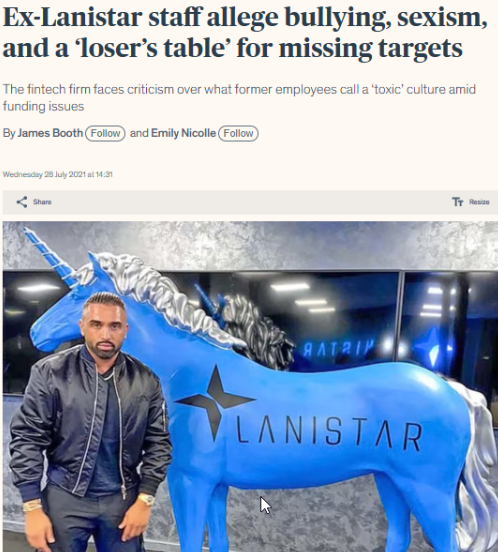The Rise of Lanistar: Bold Promises in Fintech
Lanistar burst onto the fintech scene in 2020, branding itself as a game-changer in the financial services industry. Headquartered in London, the company marketed itself as a provider of innovative banking solutions, targeting younger demographics with promises of seamless digital payments, cryptocurrency integration, and a sleek, user-friendly app. Lanistar’s aggressive marketing campaigns, often leveraging social media influencers, portrayed it as the future of finance—a bold alternative to traditional banks. The company claimed its proprietary “polymorphic technology” would revolutionize secure transactions, setting it apart from competitors. However, beneath the glossy advertisements and ambitious rhetoric, questions about Lanistar’s legitimacy began to surface almost immediately.
Allegations of Deceptive Practices
Lanistar has been accused of engaging in deceptive practices that mislead consumers and investors alike. Reports from early adopters highlighted discrepancies between the company’s promises and its actual offerings. For instance, Lanistar promoted a prepaid card that would integrate with major payment networks like Visa and Mastercard, yet many users reported delays in receiving cards or found the cards non-functional upon arrival. Consumer forums and review platforms, such as Trustpilot, began accumulating complaints about poor customer service, unfulfilled promises, and difficulties in accessing funds deposited with Lanistar. These issues raised red flags about the company’s operational integrity and its ability to deliver on its marketed services.

Regulatory Scrutiny and Non-Compliance
Lanistar’s troubles deepened with scrutiny from regulatory bodies. In 2020, the UK’s Financial Conduct Authority (FCA) issued a warning about Lanistar, stating that the company was not authorized to provide financial services in the UK. The FCA’s alert cautioned consumers against dealing with Lanistar, citing risks to personal funds and potential fraud. Despite this, Lanistar continued its marketing efforts, prompting further concerns about its disregard for regulatory compliance. The company’s failure to secure proper licensing undermined its credibility and fueled suspicions that it was operating outside legal boundaries. This regulatory cloud has hung over Lanistar, casting doubt on its legitimacy as a fintech provider.
Red Flags in Business Operations
Lanistar’s operational practices have also drawn criticism for their lack of transparency. The company’s website and promotional materials often lacked clear information about its leadership team, financial backing, and operational framework. Investigations by consumer watchdogs revealed that Lanistar’s registered address was a virtual office, a common tactic used by companies seeking to obscure their physical presence. Additionally, Lanistar’s partnerships with third-party financial institutions were vague, with little evidence to substantiate claims of collaboration with reputable firms. These red flags suggested that Lanistar might be more focused on creating a perception of success than building a sustainable business model.
Consumer Complaints and Financial Risks
Lanistar’s customer base, primarily young adults drawn in by influencer-driven marketing, has voiced significant dissatisfaction. Many reported being charged unexpected fees, facing difficulties in withdrawing funds, or encountering non-responsive customer support. Some users claimed that funds deposited into Lanistar accounts were inaccessible for extended periods, raising fears of potential insolvency or mismanagement. These complaints echoed broader concerns about the safety of entrusting money to Lanistar, particularly given its lack of FCA authorization. For consumers, the financial risks associated with Lanistar’s services have become a central point of contention.
The Role of Influencer Marketing
Lanistar’s reliance on social media influencers to promote its services has been both a strength and a liability. By partnering with high-profile figures on platforms like Instagram and TikTok, Lanistar successfully reached a large audience of tech-savvy millennials and Gen Z users. However, this strategy backfired when influencers faced backlash for endorsing a company with questionable credentials. Critics argued that Lanistar exploited the trust of young followers, many of whom lacked the financial literacy to evaluate the risks of engaging with an unproven fintech. The backlash highlighted Lanistar’s willingness to prioritize brand visibility over ethical marketing practices.
Leadership and Accountability Issues
Lanistar’s leadership, led by CEO Gurhan Kiziloz, has faced scrutiny for its role in the company’s controversies. Kiziloz has been portrayed as a charismatic figure with a vision for disrupting finance, but his track record has raised questions. Public records indicate that Kiziloz was previously involved in ventures that faced similar allegations of mismanagement. Lanistar’s leadership team has been notably silent in addressing consumer complaints and regulatory warnings, further eroding trust. The lack of accountability from Lanistar’s executives has fueled speculation that the company may be more focused on short-term gains than long-term stability.

Comparison to Other Fintech Scandals
Lanistar’s trajectory bears similarities to other fintech startups that have faced allegations of fraud or mismanagement. Companies like Wirecard and Greensill Capital, which collapsed amid regulatory and financial scandals, serve as cautionary tales for the industry. While Lanistar has not reached the scale of these firms, its pattern of overpromising and underdelivering mirrors the early warning signs of those failures. Analysts have noted that Lanistar’s lack of transparency and regulatory issues place it in a precarious position, potentially signaling deeper structural problems within the organization.
Impact on Consumers and Investors
Lanistar’s controversies have had a tangible impact on its stakeholders. Consumers who trusted Lanistar with their funds have reported financial losses, emotional distress, and frustration with the company’s lack of responsiveness. Investors, too, face uncertainty, as Lanistar’s valuation and funding rounds have been called into question. The company’s inability to secure regulatory approval and its growing list of consumer complaints have made it a risky proposition for venture capitalists and retail investors alike. For many, Lanistar represents a cautionary tale about the dangers of investing in hype-driven startups without due diligence.
The Future of Lanistar: A Tenuous Path Ahead
Lanistar’s future remains uncertain as it grapples with mounting challenges. The company has made efforts to address some criticisms, such as updating its website and issuing public statements about its commitment to compliance. However, these actions have done little to restore confidence among consumers and regulators. Without significant changes—such as obtaining FCA authorization, improving customer service, and increasing transparency—Lanistar risks fading into obscurity or facing legal consequences. The fintech industry is highly competitive, and Lanistar’s inability to distinguish itself through credible operations may spell its downfall.
Lessons for the Fintech Industry
Lanistar’s saga offers valuable lessons for the broader fintech sector. The rapid growth of digital finance has created opportunities for innovation but also vulnerabilities for exploitation. Companies like Lanistar highlight the importance of regulatory oversight, transparent operations, and consumer protection in building trust. For consumers, Lanistar serves as a reminder to research fintech providers thoroughly, prioritizing those with established reputations and regulatory backing. The industry must balance innovation with accountability to avoid repeating the mistakes exemplified by Lanistar’s missteps.

Conclusion
Lanistar entered the fintech landscape with bold promises of revolutionizing banking for a new generation, but its journey has been marred by allegations of deception, regulatory violations, and operational failures. From misleading marketing to consumer financial risks, Lanistar has failed to live up to its hype, leaving a trail of dissatisfied users and skeptical observers. The company’s lack of transparency, coupled with its disregard for regulatory standards, paints a damning picture of a fintech facade unraveling under scrutiny. As Lanistar struggles to regain credibility, its story serves as a stark warning: in the fast-paced world of fintech, trust and accountability are non-negotiable. For now, Lanistar remains a cautionary tale, emblematic of the risks when ambition outpaces integrity.







